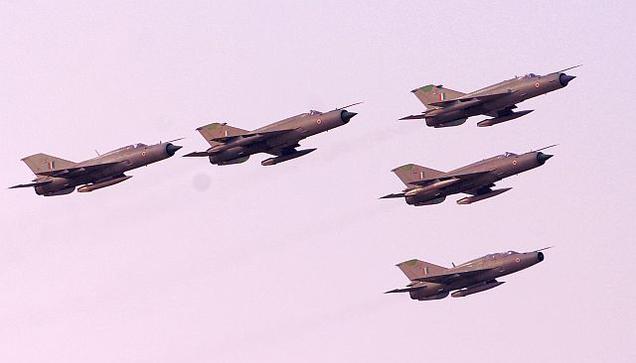 NEW DELHI, June 16;The first supersonic fighter jet of the Indian Air Force, the Russian made MiG-21 Bis, which completed 50 years in service this April despite facing criticism due to a substantial number of accidents, is likely to remain operational in its upgraded version until 2019 — two year later than they were originally scheduled to be decommissioned.
NEW DELHI, June 16;The first supersonic fighter jet of the Indian Air Force, the Russian made MiG-21 Bis, which completed 50 years in service this April despite facing criticism due to a substantial number of accidents, is likely to remain operational in its upgraded version until 2019 — two year later than they were originally scheduled to be decommissioned.
The Air Force took the decision owing to the delay in the commissioning of India’s own Tejas Light Combat Aircraft (LCA) and the purchase of 126 Rafale fighters from France for which the official contract is yet to be finalised.
The Defence Ministry had earlier stated that the Mig-21 Bis would be decommissioned in 2017. However, there has been nearly three-year delay in Tejas programme and the Air Force is yet to give operational clearance to it.
According to IAF chief Air Chief Marshal NAK Browne, India had purchased 874 MiG–21 fighters of various modifications since 1964. Of them, 264 fighters are still flying. The MiG-21 Bis’ super Kopyo multimode radar system and French-made Totem 221G ring-laser gyro aiming-navigation system are sufficient for the Indian Air Force to keep using the MiG-21 Bis until 2019. As things stand today, MiG-21 fleet’s upgraded Bison variant still forms a major chunk of the IAF fighter strength.
While three out of the 69 Indian MiG-29B/S fighters have been modernised in Russia as part of a $964 million contract inked in 2009, three more fighters are scheduled to be delivered to India later this year.
The remaining 63 MiG-29 fighter jets will be modernised at Hindustan Aeronautics Limited (HAL) in Nashik. These fighters will be fitted with the new Klimov RD-33 KM engine, the Zhuk-ME phased array radar and the Vympel R-77 beyond visual range air-to-air missile.
After a number of accidents and its eventual two-year grounding, Defence Minister A. K. Antony had said that plans to phase out equipment approaching redundancy were in place and non-upgraded MiG-27 and MiG 21 were being phased out progressively by 2016 and 2018 respectively.
Till April last year, IAF had lost more than half of its MiG21s, Mr. Antony had told Rajya Sabha. As many as 482 MiG-21s had been involved in accidents and as many as 171 pilots, 39 civilians and eight persons from other services had lost their lives in these accidents. At that time, Mr. Antony had stated that both “human error and technical defects’’ were responsible for the crashes.
Even now, MiG-21s account for nearly 10 squadrons of the IAF and the upgraded fighters present a cost-effective option to the Air Force as compared to other fighters. Several former ace fighter pilots swear by the versatility, and safety of the MiG-21 which in the 1971 war as the frontline fighter had emerged as a clear winner against the American F-104 Starfighter in air combat. MiG-21 again proved its capability and prowess during the Kargil war in 1998.
The induction of the first MiG-21s into 28 squadron began in 1963 but in the years to come the Russian fighter came to be the mainstay of the IAF. “In its long operational service, alongwith the kudos it also attracted a fair share of criticism and avoidable media scrutiny….with its sleek frontal profile, fast acceleration and a high degree of flexibility in terms of role employment for both air to air and air to ground missions – it remains the mainstay of IAF’s combat fleet for a long time,’’ recalled Air Chief Marshal Browne in the foreword which he wrote for the commemorative book to mark 50 years of MiG 21s with the IAF, written by Air Marshal Philip Rajkumar (Retd.) and Pushpindar Singh.
The IAF chief noted that post its upgrade to MiG-21 Bison in 2000, this aircraft “continues to shoulder an important share of IAF’s operational responsibilities; something which we expect to continue for some more time in the future.’’
Then, there is Air Commodore (Retd.) S. S. Tyagi, the former station commander of IAF bases in Naliya and Jamnagar, who has done 6316 sorties with the MiG-21, the maximum by any air force pilot. According to him, the MiG-21 is a very demanding aircraft that can help a pilot exalt his capabilities to the end of the skies but even a transitory lapse could be disastrous, more so during hard maneuvering.
